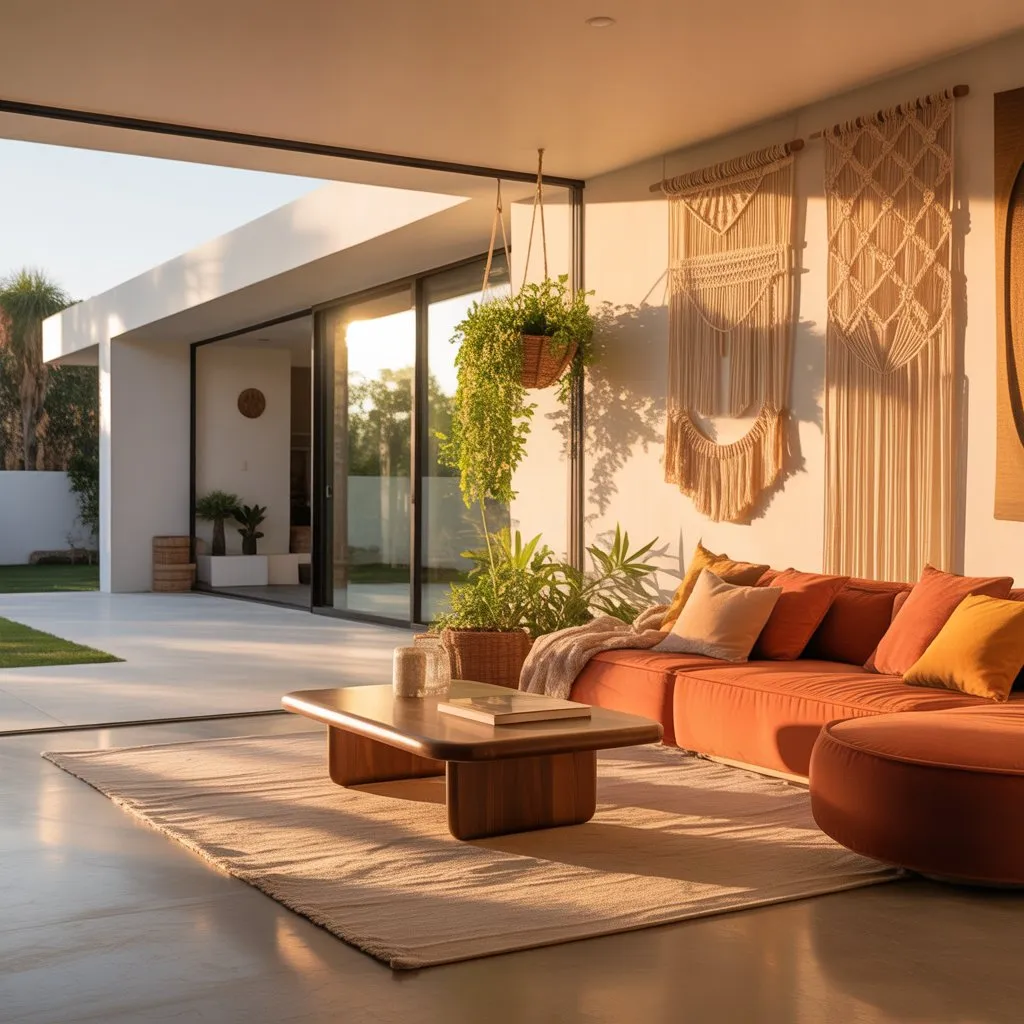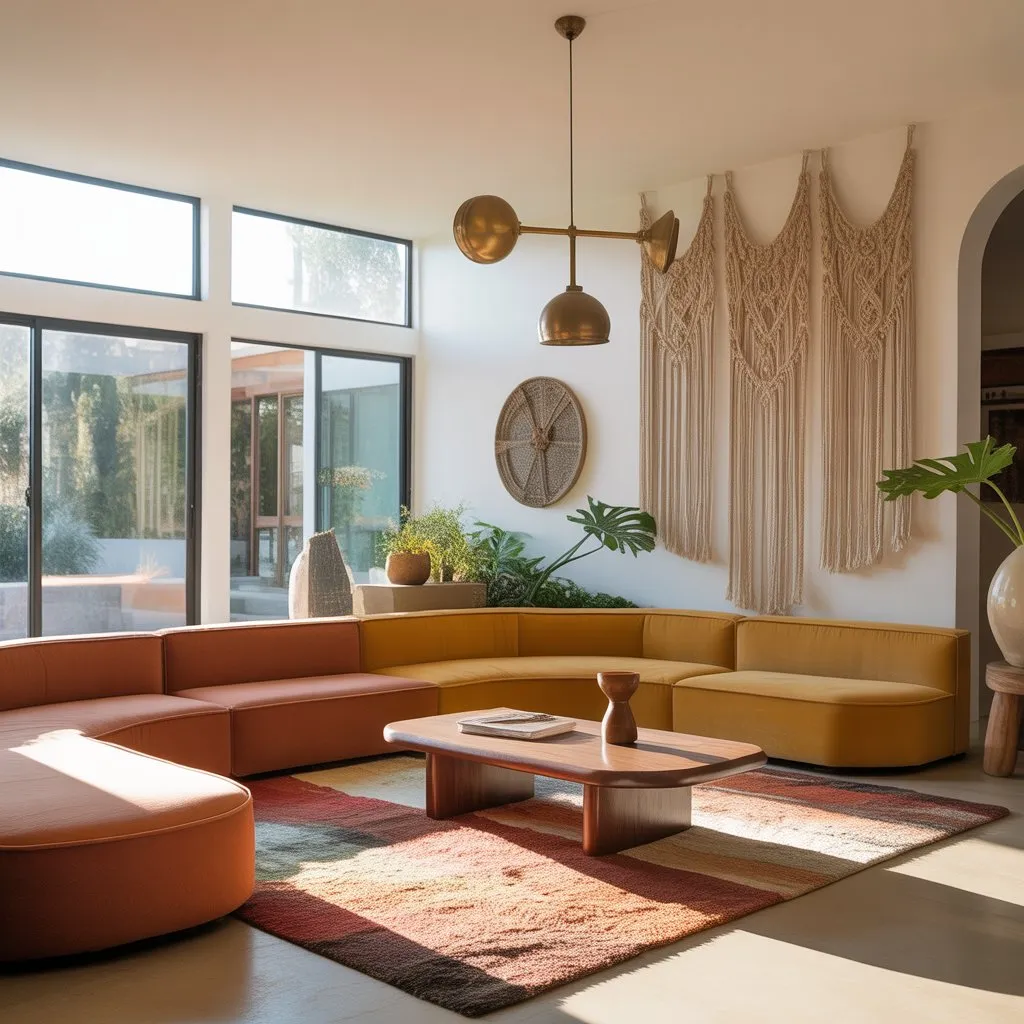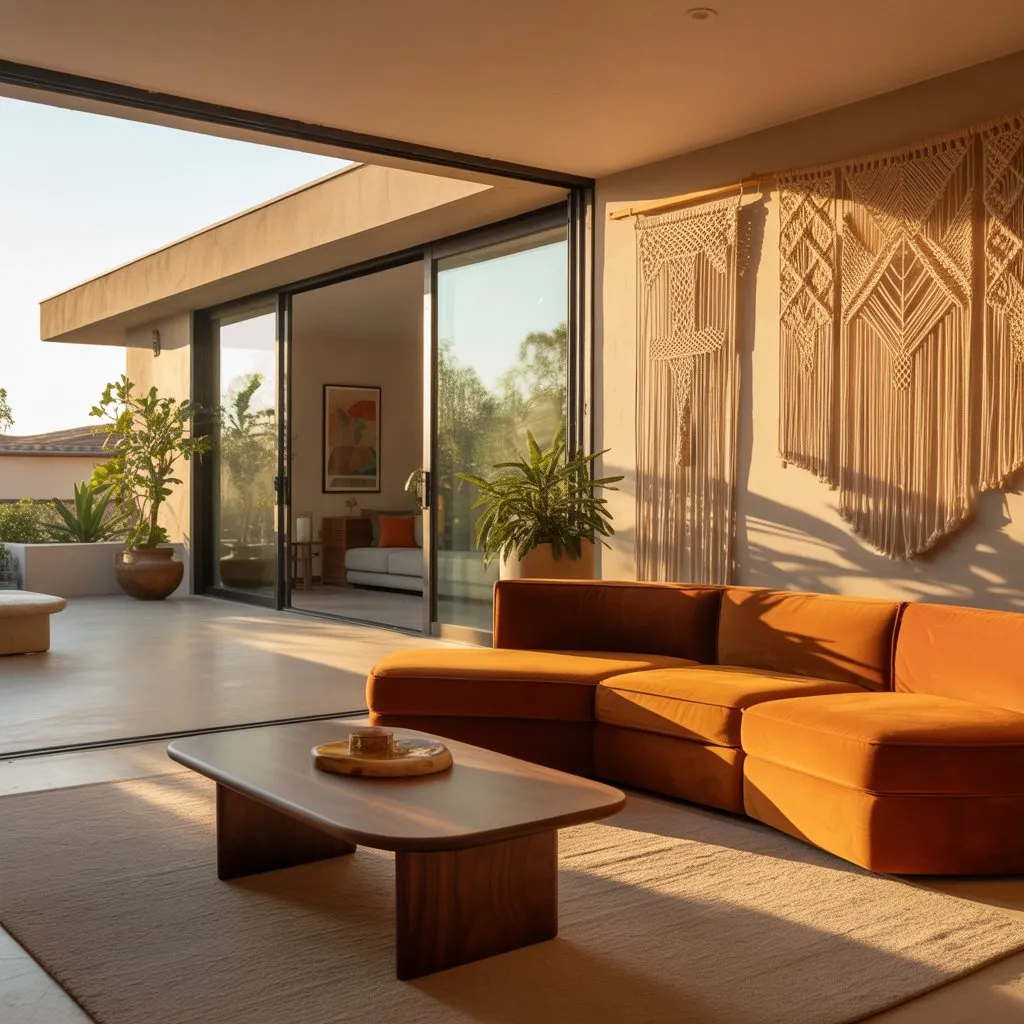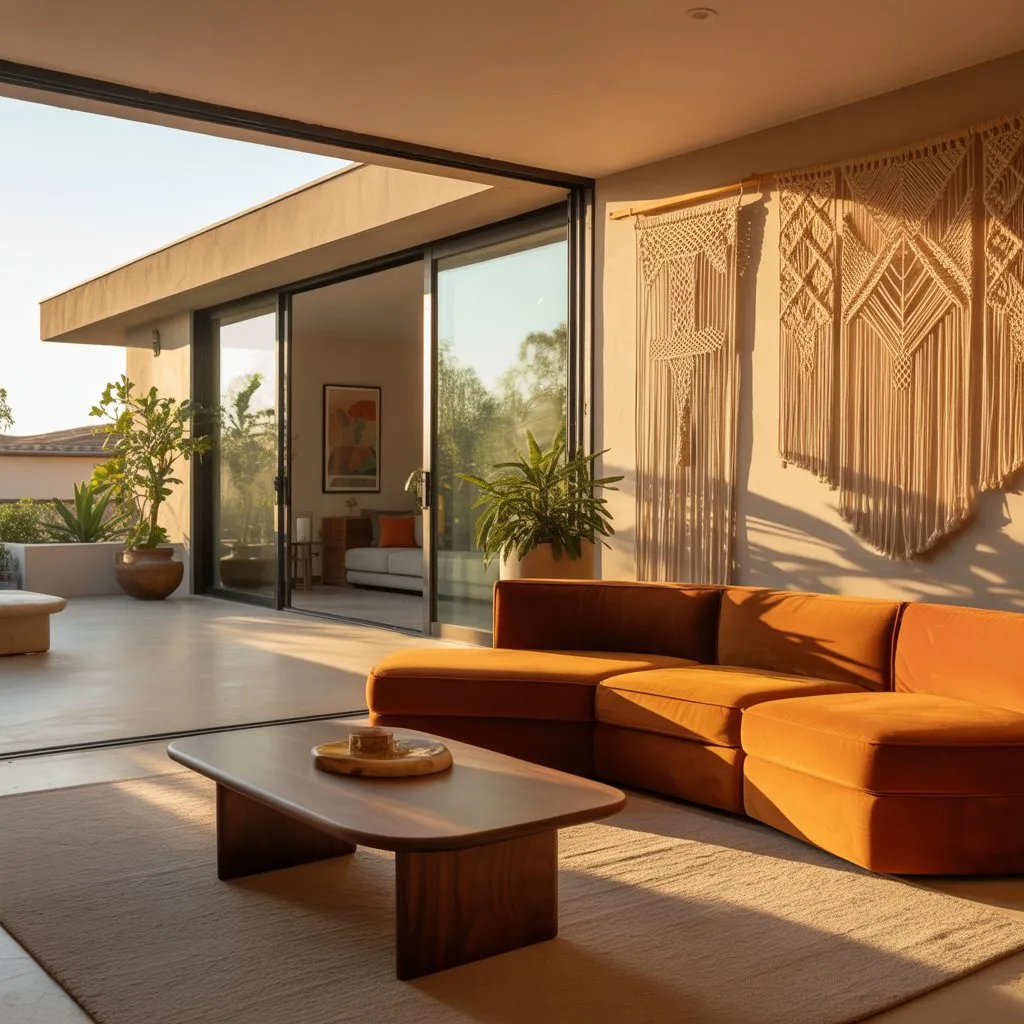Our Location
304 North Cardinal St.
Dorchester Center, MA 02124

Introduction
The charm of the 70s interior design trends is back — and it’s stronger than ever. Across the United States, homeowners and designers are rediscovering the vibrant personality, warmth, and playfulness that defined the 70s interior design style. From earthy color palettes to geometric patterns and retro furniture, this comeback is a perfect blend of nostalgia and modern sophistication. The best part? You can bring the 70s modern interior design look into your home while keeping it fresh, cozy, and relevant to 2025 living standards.
The 70s home decor trends are more than just a flashback — they reflect a cultural shift toward comfort, creativity, and individuality. Unlike the cold minimalism of the past decade, retro 70s interior design encourages bold self-expression through textures, colors, and furniture that tell a story. In this guide, we’ll explore the most timeless 70s house interior design ideas, the colors that defined the decade, and how you can incorporate them into your modern home.
Over the past few years, there’s been a huge rise in demand for 70s interior design homes across the U.S. Social media platforms like Pinterest and Instagram are flooded with posts featuring 70s modern interior design ideas — from funky patterned wallpaper to warm wooden tones. Interior designers in California, New York, and Texas are reporting more clients requesting retro 70s interior design styles that blend perfectly with contemporary layouts.
The modern 70s home interior design look has also found its way into new builds and apartments. Today’s homeowners are integrating 70s home interior trends with sustainable materials like cork, rattan, and natural wood. These choices reflect the decade’s original eco-conscious roots — but in a cleaner, more refined way.
Why it’s trending:

The 70s interior design aesthetic was all about experimentation, comfort, and self-expression. To truly capture the retro 70s home decor vibe, you need to blend organic materials, geometric prints, and warm tones with a touch of modern flair.
Color was the soul of 70s retro interior design. Think deep oranges, avocado greens, mustard yellows, and rich browns. These tones gave every room a grounded, cozy vibe that feels timeless even today.
Popular combinations:
Adding these colors to walls, upholstery, or even accent pieces brings instant vintage energy to any home. Many modern designers now pair 70s interior color schemes with white or beige to balance the bold tones for a softer, more minimalist look.
One of the defining features of 70s home decor interior design was the use of organic materials — wood, rattan, cork, and leather. These textures gave interiors a sense of warmth and authenticity that contrasts beautifully with modern polished finishes.
In today’s modern retro 70s interior design, we see a revival of these textures with an eco-conscious twist. Homeowners prefer reclaimed wood, bamboo, and vintage finds instead of synthetic materials. This combination brings both sustainability and soul to your space.
Texture layering tips:

The 70s modern interior design style embraced bold, unapologetic patterns. Geometric wallpaper, chevron rugs, and floral prints were staples of the era — and they’re making a bold comeback in today’s interiors.
When used correctly, retro geometric designs add character and rhythm without overwhelming the space. Pair them with neutral backgrounds or minimal furniture for a balanced, modern-retro feel.
Pattern ideas for your home:
One of the most iconic 1970s interior design trends was the move away from sharp edges to softer, rounded shapes. Sofas, chairs, and tables had smooth curves that gave interiors a sense of fluidity and comfort.
Today’s designers have reinterpreted this trend with modern materials like velvet, boucle, and polished wood. The result? A timeless aesthetic that feels both retro and futuristic.
Tips for incorporating curves:
Lighting played a major role in 70s home design. It was all about creating cozy, ambient spaces with layered illumination — from lava lamps to pendant lights and floor lamps with dome shades.
In a modern setting, you can achieve a similar glow using warm LED bulbs and vintage-style fixtures. Think amber glass, metallic finishes, and diffused light to replicate that signature 70s retro interior lighting.
Lighting ideas:

If there’s one thing that instantly defines 70s interior design trends, it’s the furniture. The decade brought an explosion of creativity, with pieces that emphasized comfort, round forms, and futuristic shapes. The 70s retro interior design furniture was playful, bold, and surprisingly functional — a combination that designers are loving again today.
The 70s home interior design was all about relaxed living. Sofas and chairs were low to the ground, encouraging a laid-back, social atmosphere. The goal was comfort — spaces that invited you to sink in and stay awhile.
Tips for today’s homes:
These low pieces help open up small spaces and bring a cozy, grounded feeling that suits both retro 70s interior design and modern minimalism.
Certain furniture pieces became the hallmark of 1970s interior design — such as the egg chair, bean bag, and tulip chair. These designs celebrated individuality and broke away from traditional symmetry.
Modern take:
The idea is to create focal points that embody 70s interior style — expressive, yet balanced.

Accessories were the heartbeat of 70s home decor interior design. The right mix of textures, patterns, and quirky details can transform any ordinary room into a groovy haven inspired by the 70s retro design style.
No 70s interior design home was complete without macramé wall hangings, crochet blankets, and colorful tapestries. These handmade pieces added character and reflected the era’s appreciation for craftsmanship.
How to incorporate this today:
These small details are a subtle way to bring 70s house interior design into modern spaces without going overboard.
Few things say 70s retro home interior design like a thick, luxurious shag rug. The tactile softness instantly warms up a space and contrasts beautifully with modern flooring or minimalist furniture.
Styling ideas:
Layering these textures brings authenticity and coziness — essential traits of true 70s interior design style.
Lighting defined the mood in 70s interior decor. From globe pendant lights to lava lamps, illumination was as decorative as it was functional.
📸 Image idea: A dining space with hanging globe lights and brass fixtures.
Modern ideas to recreate it:
Pairing metallic finishes with warm bulbs adds that nostalgic golden glow of a true 1970s home interior design.

The resurgence of 70s modern interior design isn’t just about copying the past. Today’s approach is more refined — blending nostalgia with contemporary aesthetics to create something timeless. Designers are bringing the best of both worlds together: retro charm and modern functionality.
📸 Image idea: A chic apartment mixing retro art, modern sofas, and wooden elements.
In the U.S., especially in cities like Los Angeles and Austin, the retro-modern 70s interior design trend has become a favorite among younger homeowners. They love the comfort and individuality of the 70s, but with sleeker finishes and neutral tones.
How to achieve this look:
The goal is harmony — where retro doesn’t feel “old,” but rather stylishly nostalgic.
Interestingly, modern designers have found a balance between the maximalist energy of 70s interior design and the clean lines of today’s minimalism. The result is “soft maximalism” — a curated approach where every bold piece still feels intentional.
📸 Image idea: Neutral living room with a single retro orange armchair and patterned rug.
Design approach:
This style feels artistic yet livable — a refined take on modern 70s house interior design.
Sustainable Retro Revival
One of the biggest appeals of 70s home interior design today is its alignment with sustainability. Vintage furniture, natural materials, and handcrafted decor fit perfectly with eco-friendly lifestyles.
📸 Image idea: A sustainably styled retro living room with reclaimed wood furniture and organic fabrics.
Eco-friendly retro tips:
This not only saves the planet but adds history and depth to your home — making retro 70s house design both stylish and responsible.
Frequently Asked Question (FAQs)
1. What is 70s interior design?
70s interior design is a nostalgic style known for warm earthy tones, retro furniture, bold patterns, and natural materials that create a cozy yet vibrant atmosphere.
2. What colors were popular in 70s interior design?
The 1970s color palette featured shades like mustard yellow, olive green, burnt orange, and brown, often paired with neutral beige or cream backgrounds.
3. How can I incorporate 70s interior design in a modern home?
Blend retro pieces with modern elements — like vintage lighting, shag rugs, and curved furniture — while keeping walls neutral for a contemporary balance.
4. What materials define 70s interior design?
Common materials include wood paneling, rattan, macramé, glass, and chrome, which add texture and warmth to the retro-inspired spaces.
5. Why is 70s interior design making a comeback?
People love its cozy, nostalgic feel and sustainable use of natural materials that fit perfectly with modern eco-friendly living.
6. What furniture works best in 70s-inspired interiors?
Curved sofas, low coffee tables, bean bags, and wooden sideboards with rounded edges are classic 70s furniture staples.
7. What patterns are typical of 70s interior design?
Expect bold geometric prints, floral wallpapers, and checkered floors — all adding a playful retro charm to your home.
8. How do lighting and lamps contribute to 70s interior design?
Pendant lamps, lava lamps, and globe lights bring a warm, ambient glow that defines 70s aesthetics.
9. Is 70s interior design budget-friendly?
Yes! You can easily recreate the look using thrift-store finds, vintage decor, and DIY macramé wall art.
10. What flooring was used in 70s interior design?
Wood parquet, linoleum, and shag carpets were common choices, giving homes a soft and earthy vibe.
11. Can I mix 70s interior design with modern minimalism?
Absolutely. Combine clean lines and neutral shades with one or two retro statement pieces for a balanced look.
12. What makes 70s interior design different from mid-century modern?
Mid-century modern focuses on simplicity and function, while 70s design adds warmth, patterns, and bolder color contrasts.
13. How can I decorate a small space with 70s style?
Use mirrors, light colors, and compact retro furniture to create an open yet nostalgic look without overcrowding.
14. What accessories complete a 70s interior design?
Add plants, ceramic vases, woven wall hangings, and retro lamps to bring the 70s aesthetic to life.
15. Where can I find authentic 70s decor pieces?
Check vintage shops, online marketplaces like Etsy, or estate sales for genuine 70s-inspired furniture and accessories.
70s Interior Design Ideas 70s Interior Design Ideas
The enduring appeal of 70s interior design lies in its fearless blend of creativity, comfort, and character. It was an era that celebrated individuality — where bold patterns, organic textures, and warm color palettes brought homes to life. In today’s world of digital minimalism and sleek modern spaces, the retro charm of the 1970s offers a refreshing counterbalance. It invites people to design spaces that feel personal, welcoming, and full of nostalgic soul.
The modern 70s interior design revival seen in American homes is proof that good design never truly disappears — it simply evolves. From earthy color schemes like burnt orange, avocado green, and mustard yellow to retro furniture pieces with curved silhouettes and wood finishes, every element adds depth and character to a home. Designers are now reinterpreting these vintage details using sustainable materials, smarter layouts, and softer tones, giving the retro 70s interior design a fresh and timeless edge.
Incorporating 70s home interior design elements doesn’t mean turning your space into a time capsule. Instead, it’s about blending the warmth of the past with the functionality of the present. For example, pairing a mid-century modern sofa with natural rattan chairs or mixing vintage lighting with minimalist decor creates a stunning balance between old and new. These touches infuse your space with authenticity, creativity, and charm — values that resonate deeply in today’s design culture.
What makes the 70s interior design style so enduring is its versatility. It adapts effortlessly to different home types — from cozy apartments to large suburban houses — and complements various tastes, whether bohemian, minimalist, or modern luxe. Homeowners love it because it feels natural and comforting, yet bold and stylish.
In essence, the revival of 70s interior design is more than a passing trend — it’s a design philosophy that celebrates comfort, freedom, and expression. It’s about transforming spaces into reflections of personality, where every texture, color, and shape tells a story. If you’re looking to bring warmth, nostalgia, and sophistication to your home, embracing the retro 70s interior design movement is a timeless choice that will never fade out of style.